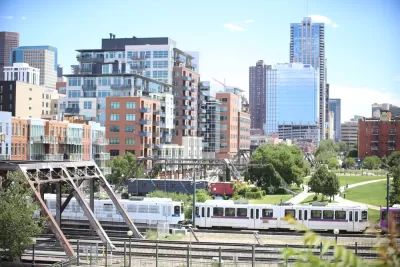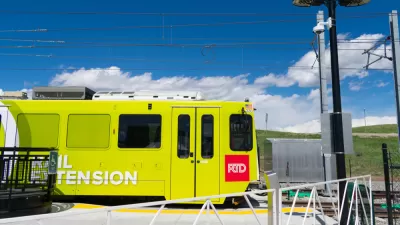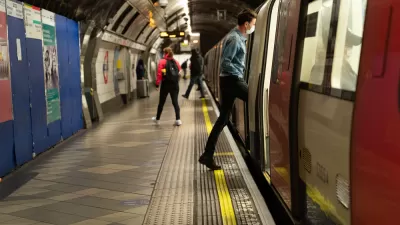The N Line between Denver and its northern suburbs opens today to the public, but N Line trains are expected to carry far fewer passengers, and lower frequencies, than originally planned.

The Regional Transportation District, the transit provider for the Denver region, is opening the N Line rail line between Downtown Denver and the city's Northern Suburbs.
An article by John Aguilar prepares the public for what will be a very strange opening indeed, with the coronavirus gutting transit ridership in the Denver region as in other parts of the country. In Denver, transit ridership has declined by 64.4 percent, according to Aguilar, during the second quarter of 2020 compared to the previous year.
The 13-mile commuter rail line connecting Union Station to Commerce City, Northglenn and Thornton is one of the only major transit projects anywhere to go operational in the midst of a global health crisis, and its launch next week raises fresh questions about what the future of public transportation will look like once the coronavirus fades into memory.
Because of the pandemic's effect on ridership, the "N-Line will likely carry less than half of the projected 5,600 to 8,100 daily riders it was expected to have at the end of its first year," reports Aguilar. RTD service designer have cut headways on the N-Line before it's even open. Trains will run every 30 minutes, down from the originally planned 20 minutes.

N Line map courtesy of the Regional Transportation District
FULL STORY: Opening of N-Line to Denver’s north suburbs a rare “bright spot” for COVID-battered transit sector

Study: Maui’s Plan to Convert Vacation Rentals to Long-Term Housing Could Cause Nearly $1 Billion Economic Loss
The plan would reduce visitor accommodation by 25,% resulting in 1,900 jobs lost.

North Texas Transit Leaders Tout Benefits of TOD for Growing Region
At a summit focused on transit-oriented development, policymakers discussed how North Texas’ expanded light rail system can serve as a tool for economic growth.

Why Should We Subsidize Public Transportation?
Many public transit agencies face financial stress due to rising costs, declining fare revenue, and declining subsidies. Transit advocates must provide a strong business case for increasing public transit funding.

How to Make US Trains Faster
Changes to boarding platforms and a switch to electric trains could improve U.S. passenger rail service without the added cost of high-speed rail.

Columbia’s Revitalized ‘Loop’ Is a Hub for Local Entrepreneurs
A focus on small businesses is helping a commercial corridor in Columbia, Missouri thrive.

Invasive Insect Threatens Minnesota’s Ash Forests
The Emerald Ash Borer is a rapidly spreading invasive pest threatening Minnesota’s ash trees, and homeowners are encouraged to plant diverse replacement species, avoid moving ash firewood, and monitor for signs of infestation.
Urban Design for Planners 1: Software Tools
This six-course series explores essential urban design concepts using open source software and equips planners with the tools they need to participate fully in the urban design process.
Planning for Universal Design
Learn the tools for implementing Universal Design in planning regulations.
Ascent Environmental
Borough of Carlisle
Institute for Housing and Urban Development Studies (IHS)
City of Grandview
Harvard GSD Executive Education
Toledo-Lucas County Plan Commissions
Salt Lake City
NYU Wagner Graduate School of Public Service





























